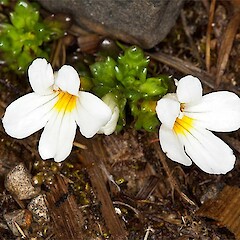Euphrasia petriei
Common name
eyebright
Synonyms
Formally grouped in Euphrasia revoluta Hook. f.
Family
Orobanchaceae
Flora category
Vascular – Native
Endemic taxon
Yes
Endemic genus
No
Endemic family
No
Structural class
Herbs - Dicotyledons other than Composites
NVS code
The National Vegetation Survey (NVS) Databank is a physical archive and electronic databank containing records of over 94,000 vegetation survey plots - including data from over 19,000 permanent plots. NVS maintains a standard set of species code abbreviations that correspond to standard scientific plant names from the Ngä Tipu o Aotearoa - New Zealand Plants database.
EUPPET
Current conservation status
The conservation status of all known New Zealand vascular plant taxa at the rank of species and below were reassessed in 2017 using the New Zealand Threat Classification System (NZTCS) – more information about this can be found on the NZTCS website. This report includes a statistical summary and brief notes on changes since 2012 and replaces all previous NZTCS lists for vascular plants.
Please note, threat classifications are often suggested by authors when publications fall between NZTCS assessment periods – an interim threat classification status has not been assessed by the NZTCS panel.
- Conservation status of New Zealand indigenous vascular plants, 2017 . 2018. Peter J. de Lange, Jeremy R. Rolfe, John W. Barkla, Shannel P. Courtney, Paul D. Champion, Leon R. Perrie, Sarah M. Beadel, Kerry A. Ford, Ilse Breitwieser, Ines Schönberger, Rowan Hindmarsh-Walls, Peter B. Heenan and Kate Ladley. Department of Conservation. Source: NZTCS and licensed by DOC for reuse under the Creative Commons Attribution 4.0 International licence.
2017 | Not Threatened
Previous conservation statuses
2012 | Not Threatened
2009 | Not Threatened
2004 | Not Threatened
Distribution
Endemic. South Island, mountains of main divide from Arthur’s Pass to western Otago and Fiordland.
Habitat
Subalpine open and rocky places.
Detailed description
Tufted perennial herb sometimes arising from woody stock; stems woody at base, much-branched, prostrate or decumbent, rooting at nodes, branches erect, 20-80 (-120) mm tall, bifariously or occasionally uniformly pubescent. Leaves sessile, crowded or occasionally distant, 5-10 (-15) x 3-6 (-8) mm, obovate-cuneate to broadly obovate or suborbicular, unequally 3-lobed at tip with obtuse to subacute terminal lobe, or more evenly and acutely 3-5 (-7) toothed, surfaces glabrous, margins thickened, sometimes ciliate with glandular or non-glandular hairs. Flowers few clustered at tips of branches on short hidden pedicels, or in more elongated raceme with obvious pedicels sometimes equal to leaves. Calyx 5-9 mm long, usually glandular-hairy and white-pubescent, sometimes almost glabrous, evenly or subevenly divided ¼-⅓ way. Corolla white, 8-12-20 mm long and diameter; tube longer than calyx; lobes of lower lip up to 8 mm wide and emarginate or not greater than 4 mm wide and entire. Anthers red-brown, margins hairy, awns usually slightly unequal. Capsule less than or equal to calyx, 4-8 x 3.5-5 mm, more or less oval, glabrous; seeds numerous.
Similar taxa
The rather variable range of forms are similar in habit to Euphrasia revoluta or Euphrasia laingii but differ distinctly from both in the shape of the leaves and the glandular pubescence of the calyx. In this latter character and in habit they resemble Euphrasia townsonii but differ from that species in leaf-shape and short pedicels. See ‘Taxonomic Notes’ below for further information.
Flowering
November – February.
Flower colours
White
Fruiting
December – March.
Life cycle
Seeds is dispersed by wind and possibly water and ballistic projection (Thorsen et al., 2009).
Etymology
euphrasia: Eye-medicine
petriei: Named after Donald Petrie (1846 -1925), Scottish born Otago botanist
TAXONOMIC NOTES
Flower-size varies greatly and can be used to divide the species into 2 more or less geographically separated forms:
In Canterbury and north-west Otago corollas are usually exceptionally large, (10-) 15-20 mm long and diameter, with lobes of lower lip 4-8 mm wide, bluntly expanded at tip and emarginate. Leaves are sometimes densely ciliate, and the plants may be up to 120 mm tall. This form (which includes the type) often occurs in company with E. revoluta sensu stricto and many mixed collections have been made. Even if the distinctive glandular pubescence is absent E. petriei is usually easily separated by its very differently shaped leaves, larger flowers, and stouter habit. However, occasionally specimens combine characters of both species and hybridism may be a factor contributing to the variability of E petriei in this part of its range.
In Fiordland and western Otago south of approximate latitude 44° corollas are much smaller, approximately 8-12 mm long and diameter, with lobes of lower lip only 2-4 mm wide and entire. Leaves are always glabrous and the plants rarely greater than 50 mm tall, though an anomalous collection from Clinton Saddle referred by Petrie to Euphrasia australis consists of luxuriant plants up to 100 mm tall with distant leaves and long pedicels. Dwarf densely tufted forms which have been collected on the Hector Mountains and Mount Pisa appear very distinct but are probably only epharmonic modifications. This form could receive varietal recognition, but as there is a possibility that Hooker’s Euphrasia antarctica var. major and/or var. grandiflora belong here no new epithet is given.
Attribution
Fact sheet prepared for NZPCN by M.D. Ward (9 November 2020) Description adapted from Allan (1961).
References and further reading
Allan, H. H. 1961. Flora of New Zealand. Volume 1. Wellington: Government Printer. Page 855.
Thorsen, M. J.; Dickinson, K. J. M.; Seddon, P. J. 2009. Seed dispersal systems in the New Zealand flora. Perspectives in Plant Ecology, Evolution and Systematics 11: 285-309
NZPCN Fact Sheet citation
Please cite as: Ward, M.D. (Year at time of access): Euphrasia petriei Fact Sheet (content continuously updated). New Zealand Plant Conservation Network. https://www.nzpcn.org.nz/flora/species/euphrasia-petriei/ (Date website was queried)






